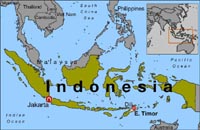Indonesian tsunami kills at least 550 people
Indonesia started installing an alert network after the 2004 tsunami that killed at least 216,000 people in a dozen Indian Ocean nations, more than half of them on Sumatra in the country's far west.

A government minister said that two tsunami monitoring buoys installed off Sumatra amid fanfare last year had broken from their moorings and were now being repaired on land, underscoring the problems in maintaining the high-tech system.
The powerful quake sent towering waves crashing into a 180-kilometer (110-mile) stretch of Java's southern coast, destroying scores of houses, restaurants and hotels. Cars, motorbikes and boats were left mangled amid fishing nets, furniture and other debris.
Nearly 550 people were killed and 323 others were missing, said Indonesia's national disaster coordinating board, adding that more than 50,000 had fled their homes, either because the structures were damaged or destroyed or because people feared more killer waves, the AP reports.
Authorities did not pass on any warnings to officials or residents on the coast despite receiving two bulletins from regional tsunami agencies that the quake had the potential to trigger a killer wave.
Since the disaster, officials have given different explanations of their actions after the warnings were received, as well as the timeline of events, leading to criticism by lawmakers and the media in the country worst hit by the 2004 Asian tsunami.
Subscribe to Pravda.Ru Telegram channel, Facebook, RSS!





